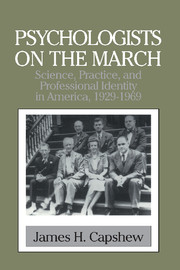Book contents
- Frontmatter
- Contents
- Acknowledgments
- List of Abbreviations
- Introduction: The Psychologists' War
- Interlude I
- 1 Growing Pains: After the Great War
- 2 Mobilizing for World War II: From National Defense to Professional Unity
- 3 Home Fires: Female Psychologists and the Politics of Gender
- Interlude II
- 4 Sorting Soldiers: Psychology as Personnel Management
- 5 Applied Human Relations: The Utility of Social Psychology
- 6 From the Margins: Making the Clinical Connection
- 7 Engineering Behavior: Applied Experimental Psychology
- Interlude III
- 8 A New Order: Postwar Support for Psychology
- 9 Remodeling the Academic Home
- Interlude IV
- 10 The Mirror of Practice: Toward a Reflexive Science
- 11 Beyond the Laboratory: Giving Psychology Away
- Interlude V
- Epilogue: Science in Search of Self
- Index
4 - Sorting Soldiers: Psychology as Personnel Management
Published online by Cambridge University Press: 06 July 2010
- Frontmatter
- Contents
- Acknowledgments
- List of Abbreviations
- Introduction: The Psychologists' War
- Interlude I
- 1 Growing Pains: After the Great War
- 2 Mobilizing for World War II: From National Defense to Professional Unity
- 3 Home Fires: Female Psychologists and the Politics of Gender
- Interlude II
- 4 Sorting Soldiers: Psychology as Personnel Management
- 5 Applied Human Relations: The Utility of Social Psychology
- 6 From the Margins: Making the Clinical Connection
- 7 Engineering Behavior: Applied Experimental Psychology
- Interlude III
- 8 A New Order: Postwar Support for Psychology
- 9 Remodeling the Academic Home
- Interlude IV
- 10 The Mirror of Practice: Toward a Reflexive Science
- 11 Beyond the Laboratory: Giving Psychology Away
- Interlude V
- Epilogue: Science in Search of Self
- Index
Summary
In the summer of 1943 a paperback book entitled Psychology for the Fighting Man appeared in U.S. bookstores and Allied post exchanges around the world. The pocket-sized Penguin edition, costing twenty-five cents, joined a list of books aimed at the wartime mass market, both military and civilian. Directed to “the fighting man himself,” the volume adopted a conversational tone in explaining “what you should know about yourself and others.”
From its bright red cover to its snappy chapter titles, Psychology for the Fighting Man was designed to capture the attention of the average reader. The twenty short chapters were written to stand individually and could be read in any order. The topics ranged across the entire spectrum of contemporary psychology, from motivation (“Morale”) to sensation and perception (“Sight as a Weapon”), from personnel selection (“The Right Soldier in the Right Job”) to social and cultural psychology (“Differences among Races and Peoples”).
Psychology for the Fighting Man became a bestseller, with nearly 400,000 copies in circulation by the end of the war. The book was reviewed widely upon publication. The press was positive, if somewhat bland, in its evaluations. The New York Times Book Review called it “a why-you-behave-as-you-do sort of a book, scientifically accurate, militarily correct and keyed to interest men of action whether colonels or corporals or anyone literate enough to read a newspaper.” Psychologists gave it high praise and tended to find their own prejudices confirmed in its pages.
- Type
- Chapter
- Information
- Psychologists on the MarchScience, Practice, and Professional Identity in America, 1929–1969, pp. 97 - 115Publisher: Cambridge University PressPrint publication year: 1999



